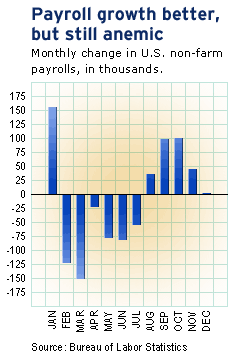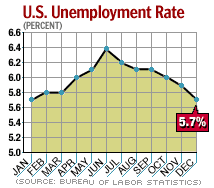NEW YORK (CNN/Money) - U.S. employers expanded their payrolls -- but just barely -- in December, according to a government report Friday that fell far short of Wall Street forecasts.
Though the unemployment rate posted a surprising decline, and many economists believe the job market will improve in 2004, Friday's report probably will keep Fed policy-makers on hold and may put some political pressure on President Bush.
| 
| |

| 
| 
|

|
 Lee Price from the Economic Policy Institute comments on the disappointing December jobs report. Lee Price from the Economic Policy Institute comments on the disappointing December jobs report.
|
 Play video
Play video
(Real or Windows Media)
|
| 
|

|
|
Payrolls outside the farm sector grew by just 1,000 jobs, the Labor Department said, compared with a downwardly revised gain of 43,000 in November. It was the fifth straight month of payroll gains. The unemployment rate fell to 5.7 percent from 5.9 percent in November.
Economists, on average, expected 148,000 new jobs and unemployment at 5.9 percent, according to Briefing.com.
"We were expecting to celebrate New Year's and instead got slapped with a pink slip," said Bill Cheney, chief economist at John Hancock Financial Services.
Though it seems inconsistent for the unemployment rate to fall despite virtually no job growth in December, the two numbers are generated by separate surveys. The payroll number comes from a much broader survey of businesses, while the unemployment rate comes from a survey of households.

In recent months, the household survey has been much stronger than the business survey -- a sign, some economists think, that small businesses and start-ups are hiring -- numbers not reflected in the payroll survey. But the household survey showed a loss of 54,000 jobs last month.
What's more, 309,000 left the labor force, including those who simply stopped looking in a weak job market, which also probably helped push unemployment lower.
On Wall Street, stocks were mixed but Treasury bond prices soared, knocking yields lower, as investors bet rates aren't heading higher anytime soon.
The nation has lost 2.4 million since February 2001, just before the last recession began, the longest such stretch of pain since World War II. Nearly 800,000 of those jobs have disappeared since the recession ended in November 2001.
| Related stories
|

|
|
|
|
And while the economy grew at a blistering 8.2 percent rate in the third quarter -- and will probably grow a still healthy 4 percent or so this year -- businesses have been able to generate much of that growth by pushing their current workers harder and using technology to produce more efficiently.
Exploding productivity -- or output per worker hour -- is good news for corporate profits and for workers' wages. But it may mean a much slower job-market recovery, particularly since many employers continue to look for cheaper labor offshore.
"In a global economy, domestic demand and global supply continue to suggest ... less labor demand than usual" at home, said John Silvia, chief economist at Wachovia Securities.
Cover for Fed stance; political downer for Bush
The report seems likely to reinforce the Fed's stated desire to hold its key short-term interest rate at a 40-year low.
Despite signs inflation may pick up, some economists believe the so-called structural changes in the labor market should keep jobs relatively scarce and labor costs low, allowing the Fed to stay on hold longer.
"The much weaker-than-expected rise in payrolls truly confirms the cautious demeanor expressed by various Federal Reserve policy officials," said Anthony Chan, chief economist at Banc One Investment Advisors.
A weak job market could prove tough for President Bush as the November election approaches. When pushing for tax cuts earlier this year, Bush promised his proposals would create 300,000 jobs a month.
And more recently, Treasury Secretary John Snow suggested the economy could start adding 200,000 jobs a month as early as October 2003. So far, neither prediction has come anywhere close to true.
President Bush said that all signs pointed to strength in the economy. "I'm optimistic,'' the president told a forum on small business, according to Reuters. "All of the signs in our economy are very strong.''

Other administration officials called for making permanent the tax cuts passed in 2003.
Certainly, most economists believe stronger hiring will come in 2004, and the National Federation of Independent Business said Friday that its December survey of small businesses showed hiring plans at their strongest level since August 2000.
"To handle the rising level of spending in 2004, firms will have to increasingly rely on the addition of new workers -- job creation is about to ramp up," the NFIB said.
Wages, temp payrolls rise, but workweek shrinks
So far, however, job growth is still "a matter of faith and forecasting rather than fact," in the words of Bill Cheney at John Hancock.
In its report, the department said payrolls in service industries such as education and health care grew just 13,000 in December. Retailers lost 38,000 jobs, possibly reflecting bad weather in early December and a strike at grocery stores in California.
Temporary help payrolls rose by 30,000 jobs. Typically, this is a sign employers are gearing up to make permanent hires. But temp payrolls have risen for eight straight months without much permanent job growth.
Manufacturing shed 26,000 jobs -- the 41st straight month of falling factory payrolls.
Given strength in recent manufacturing surveys -- including the closely watched monthly survey from the Institute for Supply Management -- many economists had hoped the factory sector, which has lost 3.1 million jobs since peaking in March 1998, would finally add jobs.
Average hourly wages rose to $15.50 from $15.47 in November. But average weekly earnings actually fell $2.08 to $522.35. Wage growth is crucial for consumer spending, which fuels two-thirds of the economy.
Ominously, the average work week shrank to 33.7 hours from 33.9 in November, indicating businesses decreased activity.
And the percentage of private firms adding to payrolls also fell from November's three-year high. The November reading had fueled hope for a broad-based improvement in the labor market.

|

